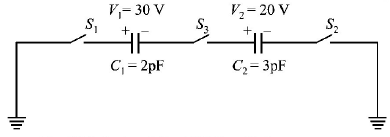Question
In the given circuit, a charge of $$+80\mu C$$ is given to the upper plate of the $$4\mu F$$ capacitor. Then in the steady state, the charge on the upper plate of the $$3\mu F$$ capacitor is
In the given circuit, a charge of $$+80\mu C$$ is given to the upper plate of the $$4\mu F$$ capacitor. Then in the steady state, the charge on the upper plate of the $$3\mu F$$ capacitor is

A.
$$ + 32\mu C$$
B.
$$ + 40\mu C$$
C.
$$ + 48\mu C$$
D.
$$ + 80\mu C$$
Answer :
$$ + 48\mu C$$
Solution :
The total charge on plate $$A$$ will be $$ - 80\mu C.$$ If $${q_B}$$ and $${q_C}$$ be the charges on plate $$B$$ and $$C$$ then
$${q_B} + {q_C} = 80\mu C\,......\left( 1 \right)$$

Also $$2\mu F$$ and $$3\mu F$$ capacitors are in parallel. Therefore,
$$\eqalign{ & \frac{{{q_B}}}{2} = \frac{{{q_C}}}{3} \cr & \therefore \frac{{80 - {q_C}}}{2} = \frac{{{q_C}}}{3} \cr & \therefore 240 - 3{q_C} = 2{q_C} \cr} $$
This charge will obviously be positive.
The total charge on plate $$A$$ will be $$ - 80\mu C.$$ If $${q_B}$$ and $${q_C}$$ be the charges on plate $$B$$ and $$C$$ then
$${q_B} + {q_C} = 80\mu C\,......\left( 1 \right)$$

Also $$2\mu F$$ and $$3\mu F$$ capacitors are in parallel. Therefore,
$$\eqalign{ & \frac{{{q_B}}}{2} = \frac{{{q_C}}}{3} \cr & \therefore \frac{{80 - {q_C}}}{2} = \frac{{{q_C}}}{3} \cr & \therefore 240 - 3{q_C} = 2{q_C} \cr} $$
This charge will obviously be positive.

